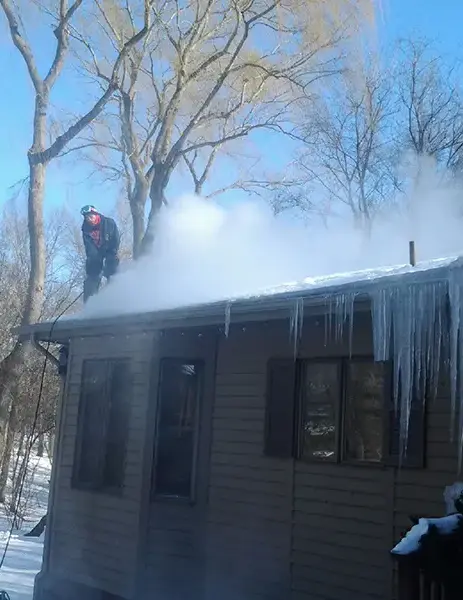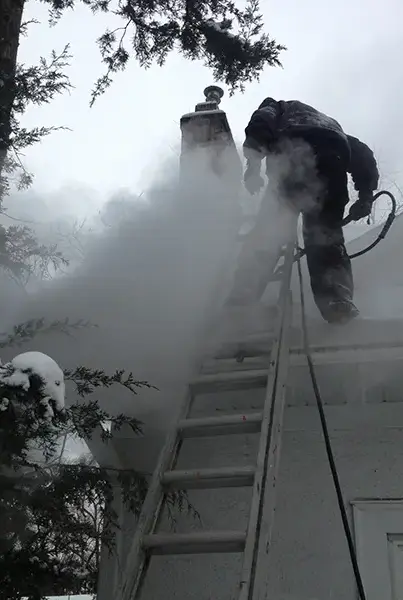Say Goodbye to Ice Dams
Trust the Twin Cities' Top Experts for Safe, Effective Removal
Ice dams can cause significant damage to your roof and interiors if not addressed promptly. Our expert team uses specialized equipment to safely and efficiently remove ice dams, preventing water intrusion and safeguarding your home.
Is ice growing on your roof? Are you seeing water damage in your home?
Gopher Property Services offers a professional and efficient ice dam removal service, ensuring your home is safe and secure from winter weather damage.
Gopher Property Services provides excellent ice and snow services for your home or business in the Twin Cities.
Efficient residential ice dam removal, protecting homes from winter damage
Reliable commercial ice dam removal, safeguarding businesses from winter hazards
Professional commercial snow plowing, ensuring a safe, accessible business all winter
Reach out to us by phone 612-331-3713 (24 hours a day) or by filling out the Free Quote form here and we will get back to you ASAP!
Experience peace of mind with a clean and safe roof after our expert ice dam removal services.
Homeowners like you choose us for our reliable, expert service that guarantees a safe and ice-free home all winter long.
Our customers return to us because we take care of them and make sure their home is safe and free from ice damage year after year during our cold Minnesota winters.
Our team has years of experience in effectively removing ice dams, ensuring quality and reliability.
We prioritize the safety of your property with insured, skilled professionals and state-of-the-art equipment.
We respond quickly to your needs, providing fast and efficient service to minimize any inconvenience or further damage to your home.


 An ice dam is a ridge of ice that forms at the edge of a roof and prevents melting snow from draining off. The water that backs up behind the dam can leak into a home and cause damage to walls, ceilings, insulation, and other areas.
An ice dam is a ridge of ice that forms at the edge of a roof and prevents melting snow from draining off. The water that backs up behind the dam can leak into a home and cause damage to walls, ceilings, insulation, and other areas.
Removing ice dams is crucial to prevent water damage to your home’s interior. Water trapped by ice dams can seep under roof shingles and into your home, potentially causing structural damage and mold growth.
At Gopher Property Services, we use safe, effective methods like steam removal to gently melt the ice without damaging your roof. This technique ensures that the ice is thoroughly removed while preserving the integrity of your roofing materials.
We pride ourselves on our rapid response times. In most cases, we can offer same-day or next-day service, especially during peak winter months, to address your ice dam removal needs promptly.
Yes, all of our services are fully insured. Our team is trained in safe, efficient ice dam removal techniques, giving you peace of mind that both your property and our staff are protected.
We stand by the quality of our work with a satisfaction guarantee. If you have any concerns after our service, we are committed to addressing them to ensure your complete satisfaction.
We serve a wide range of areas including Eagan, Rosemount, Apple Valley, Burnsville, Bloomington, Richfield, Edina, Shakopee, St. Paul, and Minneapolis and more!
We serve a wide range of areas including Minneapolis, Columbia Heights, Fridley, Spring Lake Park, Mounds View, St. Anthony, Robbinsdale, Golden Valley, Shoreview, and many others.
The cost of ice dam removal can vary based on the extent of the damming and the size of your roof. We provide free, no-obligation estimates tailored to your specific situation to ensure transparent pricing.
Scheduling a service is easy! You can call us, email, or fill out our online form to set up an appointment. Our team will work with you to find a convenient time to assess and address your ice dam issues.
We are a management company. We manage residential and commercial properties for our investors. Last year the ice dams were really building up on our properties. We called Gopher to help us, and they sure did. They met our expectations and then some.
Oh yes, the good old ice dam problems of last year. Man, I was in a panic. I had water coming in my house and had no idea what was going on. I was told by my neighbor to call Gopher. I did. How easy was that. They came with their steaming machine and removed the ice by melting it off my roof. The water stopped leaking. Nice job, Gopher!
I am a school teacher. I have to be to work. The water was leaking into my house and I didn’t have time to meet the Gopher Crew. Luckily, they were able to take care of it while I was at work. I don’t know what I would have done without their help. They did the job without me meeting them there and were able to charge my credit card once I approved their work.
Gopher was able to make it over to my house to remove my ice dam within one day. Justin was so easy to deal with and he did such a professional job. I will call them again if I need an ice dam removed.
Ice dams are a common winter problem for many homeowners in Minnesota. Understanding how they form and the damage they can cause is crucial for effectively managing and preventing them. An ice dam is a ridge of ice that forms at the edge of a roof and prevents melting snow from draining as it should. The formation of these ice dams involves a combination of temperature, heat loss from the house, snow cover, and outside weather conditions.
The formation of ice dams begins with heat loss from the house. This heat escapes through the roof and melts the snow lying on the roof’s surface. While the roof’s upper portion may be warm enough to cause melting due to heat escaping from the attic, the lower part of the roof, the eaves, remains colder. Since these eaves extend beyond the walls of the house, they are not warmed by the attic heat and thus stay much cooler.
When the melted snow from the upper, warmer part of the roof flows down to the colder eaves, it refreezes, gradually building up into a mound of ice. As this process continues, the ice dam grows larger and starts to trap more and more water behind it. This trapped water can then seep under roof shingles and eventually into the insulation and walls of the house, leading to damage such as stained ceilings, peeling paint, and in severe cases, mold and structural damage.
Preventing ice dams primarily involves improving attic insulation and ventilation to minimize heat loss:
Homeowners can also install heat tapes along the eaves to prevent ice from forming. However, addressing the root causes such as insulation and ventilation is a more effective long-term solution.
Understanding the dynamics of how ice dams form and the factors that contribute to their development is crucial for protecting your home from the damage they can cause during the winter months. Through proper home maintenance and strategic improvements, the risk of ice dams can be significantly reduced, leading to a safer and more comfortable home environment.
In the Twin Cities, where winter can be particularly harsh, ice dams are a common seasonal nuisance for many homeowners. Removing these ice formations is crucial to prevent damage to roofs and underlying structures. One of the most effective and safest methods for removing ice dams is through the use of steamers. This technique not only ensures the ice is removed efficiently but also minimizes the risk of damaging the roofing materials.
Steam removal involves using high-temperature steam to melt the ice dams from the roof. The process employs a specialized steaming machine that heats water to a boiling point and then directs the steam through a hose and nozzle towards the ice dam. This steam is hot enough to quickly melt the ice without the need for physical force, which can damage shingles and other roofing components.
The key advantage of using steam for ice dam removal is its precision and safety. The steam can be carefully directed to target only the ice, thereby protecting the integrity of the roof. Unlike other methods such as using a hammer or chisel, steam does not involve any banging or scraping, which can easily dislodge or break shingles.
The process of steam ice dam removal in the Twin Cities generally follows several critical steps:
The preference for steam removal in the Twin Cities stems from several factors. Firstly, the method is safe for all types of roofing materials, including asphalt shingles, metal, and tile. Secondly, the extreme cold in Minnesota makes other ice removal methods like salt or chemicals less effective and potentially harmful to both the roof and the environment.
Steam removal is an effective, safe, and environmentally friendly method for dealing with ice dams in the Twin Cities. By using this method, homeowners can ensure that their roofs are cleared of ice dams without risking damage to their property. The technique requires professional handling to ensure efficiency and safety, making it crucial for homeowners to engage experienced professionals specialized in this method. As winters continue to challenge homeowners with harsh conditions, steam removal stands out as the best practice for managing ice dams and preserving the longevity of roofing systems.